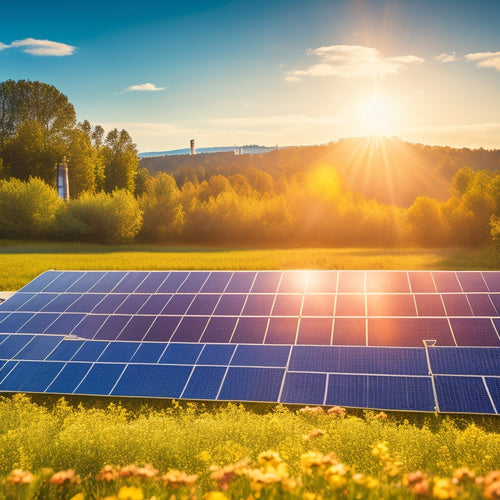
Household Solar Panel System
Share
By installing a household solar panel system, you'll reduce your carbon footprint by approximately 3-4 tons of CO2 emissions per year, making a significant contribution to a cleaner and more sustainable environment. You'll also benefit from financial incentives, including government tax credits and rebates, which can cover up to 30% of the total system cost. Plus, you'll enjoy significant reductions in energy bills, as you generate your own power and reduce your reliance on grid electricity. As you investigate the world of household solar panel systems, you'll uncover even more ways to optimize your energy independence and savings.
The Essentials
- Household solar panel systems reduce carbon footprint, offering a renewable energy source and environmental benefits.
- Financial incentives, such as tax credits and rebates, can offset up to 30% of the total system cost.
- Solar panels generate free electricity during daylight hours, reducing energy bills and promoting energy independence.
- Proper system design, installation, and maintenance are crucial for maximizing energy output and conversion rates.
- Real-time monitoring and analytics provide insights into performance, enabling data-driven optimization decisions and issue detection.
Reduce Carbon Footprint Now
By switching to a household solar panel system, you'll greatly lower your energy bills and reduce your reliance on the grid.
This means you'll be producing clean energy and decreasing your carbon footprint, contributing to a healthier environment.
With an all-encompassing solar power system for your house, you can eliminate rising electricity bills and take care of the environmental impact of traditional energy sources.
Lower Energy Bills
Nearly 80% of homeowners who install a household solar panel system report a significant reduction in their energy bills. You can join this group and start reaping the benefits of lower energy bills.
With a solar panel system, you'll be generating your own electricity and relying less on the grid, which means you'll be taking control of your energy needs and reducing your reliance on the grid Renewable Energy Solutions. Additionally, solar power and battery storage systems enable consumers to break free from their dependence on the grid and reduce their electricity bills. This means you'll be paying less to your utility company, and your energy savings will add up quickly.
In addition to the energy savings, you'll also be eligible for financial incentives. The government offers tax credits and rebates to homeowners who invest in solar energy. These incentives can help offset the initial cost of the system, making it more affordable and increasing your return on investment.
As you enjoy the freedom of generating your own clean energy, you'll also be enjoying the financial freedom that comes with lower energy bills. With a household solar panel system, you'll be saving money and reducing your reliance on the grid. It's a win-win situation that's hard to pass up.
Go Green Today
As you leverage the power of solar energy, you'll not only reduce your energy bills but also make a significant impact on the environment. By shifting to a household solar panel system, you're contributing to a cleaner and healthier planet for future generations.
| Benefits | Description | Impact |
|---|---|---|
| Reduced Carbon Footprint | Lower greenhouse gas emissions | 3-4 tons of CO2 reduction per year |
| Renewable Energy Source | Capturing sun's energy | 100% clean and sustainable power |
| Solar Incentives | Government tax credits and rebates | Up to 30% of total system cost |
| Energy Independence | Generating your own power | Reduced reliance on grid electricity |
| Enhanced Property Value | Increased appeal to eco-conscious buyers | Up to 17% increase in property value |
Save Money on Bills
By installing a household solar panel system, you'll greatly lower your energy costs, which translates to reduced monthly expenses.
In addition, with efficient solar power panels, you'll be generating clean energy and reducing your carbon footprint solar energy solutions.
Your solar panels will generate free electricity during the day, reducing your reliance on the grid and shrinking your utility bills.
This means you'll be saving money on your energy bills, putting more cash back in your pocket every month.
Lower Energy Costs
Your energy-hungry appliances and lighting systems are major contributors to your hefty electricity bills. However, with a household solar panel system, you can greatly lower your energy costs.
By utilizing the power of the sun, you can generate electricity and reduce your reliance on the grid. This means you'll be paying less for electricity, and more of your hard-earned money will stay in your pocket.
Moreover, you can take advantage of solar incentives, such as net metering, which allows you to sell excess energy back to the grid and offset your energy consumption. This not only reduces your energy bills but also increases your independence from the grid.
Additionally, with energy storage solutions, you can store excess energy generated during the day for use during the night or on cloudy days, further reducing your energy costs.
Reduce Monthly Expenses
Since you're generating your own clean energy, you'll greatly reduce your monthly expenses by slashing your electricity bills. This means you'll have more money in your pocket for the things that matter most.
With a household solar panel system, you'll be producing your own energy, reducing your reliance on the grid, and enjoying energy independence.
As a result, your monthly expenses will decrease considerably. You'll no longer be at the mercy of rising electricity rates, and you'll be able to budget with confidence.
The financial savings will add up quickly, giving you the freedom to allocate your resources as you see fit. Imagine being able to invest in your future, pay off debt, or simply enjoy the peace of mind that comes with having extra cash on hand.
Maximum Power Point Tracking
As you consider your household solar panel system, you'll want to guarantee you're getting the most out of your energy harvesting setup.
Maximum power point tracking (MPPT) is a vital component that optimizes energy harvesting efficiency by continuously monitoring and adjusting the system's operating voltage to match the maximum power point of the solar panels.
By incorporating a deep cycle battery off grid energy storage into your system, you can store excess energy for backup power during outages.
With MPPT, you'll have real-time power monitoring capabilities, allowing you to track your system's performance and make data-driven decisions.
Optimizing Energy Harvesting Efficiency
Optimizing Energy Harvesting Efficiency
Most solar panel systems operate at a suboptimal level, typically around 70% efficiency, due to variations in temperature, irradiance, and panel mismatch. However, you can optimize energy harvesting efficiency by implementing maximum power point tracking (MPPT) technology. MPPT guarantees that your solar panel system operates at its maximum power output, despite these variations.
You can further enhance energy harvesting efficiency by optimizing solar panel placement. Proper placement of solar panels can considerably increase energy output. Consider factors like shading, orientation, and tilt when installing your solar panels.
Additionally, incorporating energy storage solutions like batteries can help you store excess energy generated during the day for use during the night or on cloudy days. This guarantees a steady supply of energy and maximizes your solar panel system's potential.
Real-Time Power Monitoring
You've taken steps to optimize energy harvesting efficiency, but how do you assure your system is performing at its best in real-time? Real-time power monitoring is the answer.
With advanced maximum power point tracking (MPPT) technology, you can confirm your solar panel system is operating at peak performance. This technology continuously monitors your system's energy production and adjusts the operating voltage to optimize energy harvesting.
Real-time analytics enable you to track your energy consumption and production in real-time, providing significant perspectives into your system's performance. You can identify areas of inefficiency and make data-driven decisions to optimize your system.
With real-time monitoring, you can also detect potential issues before they become major problems, reducing downtime and increasing overall system reliability.
Assess Your Roof's Shading
You'll need to identify the shading pattern on your roof, considering the time of day, season, and year, to determine how it'll impact your solar panel system's performance.
Analyze your roof's obstructions, such as trees, chimneys, and vents, to understand how they'll cast shadows on your panels. This is essential because photovoltaic cells convert sunlight into electricity, and shading can greatly reduce their efficiency.
Additionally, a thorough assessment will help you optimize your system's design to minimize energy losses. By understanding these factors, you'll be able to design a system that maximizes energy production despite the shading.
Shading Pattern Identification
Frequently, homeowners overlook the significance of shading patterns when evaluating their roof's suitability for a solar panel system. However, understanding these patterns is essential in determining the system's energy output.
To identify shading patterns, you'll need to conduct a shading analysis. This involves evaluating the impact of surrounding objects, such as trees, buildings, and chimneys, on your roof's solar performance.
You can do this by observing your roof at different times of the day and year. Note the areas that receive direct sunlight and those that are shaded. You can also use online tools or consult with a solar panel professional to get a more accurate evaluation.
The shading analysis will help you identify the best locations for your solar panels, ensuring maximum energy production. It'll also help you determine the ideal panel configuration and tilt to minimize shading effects.
Roof Obstruction Analysis
Beyond trees and surrounding structures, your roof itself can harbor obstructions that impede solar panel performance. You need to assess your roof's shading to verify maximum energy production.
Roof obstructions can reduce energy output, increase installation challenges, and compromise the overall effectiveness of your solar panel system.
To conduct a roof obstruction analysis, start by examining your roof's orientation. Is it south-facing, west-facing, or east-facing? A south-facing roof with minimal shading receives the most sunlight throughout the day, making it ideal for solar panels.
Next, inspect your roof for obstructions like skylights, vents, and chimneys. These can cast shadows on your solar panels, reducing their efficiency. Consider the size and placement of these obstructions to determine their impact on your solar panel system.
Higher Energy Conversion Rate
You'll want to optimize your household solar panel system for efficient energy harvesting, as it directly impacts your energy conversion rate.
This means selecting high-quality photovoltaic cells that can capture more energy from the sun's rays.
Efficient Energy Harvesting
Most modern household solar panel systems boast an impressive energy conversion rate of around 20%, with high-efficiency modules capable of reaching up to 23%. As you investigate efficient energy harvesting, you'll find that advancements in solar panel technology have greatly improved the ability to capture and convert sunlight into usable energy.
To maximize energy production, you should consider optimizing system sizing, installation techniques, and maintenance practices. Energy storage solutions, such as batteries, can also enhance your system's overall performance and provide backup power during grid outages.
Additionally, taking advantage of residential incentives and understanding regulatory considerations can help you get the most out of your investment.
When evaluating your system's performance, pay attention to key performance metrics, such as energy output and grid integration. As you aim for energy independence, remember that efficient energy harvesting not only reduces your reliance on the grid but also minimizes your environmental impact.
Frequently Asked Questions
Can I Install Solar Panels on a Metal or Tile Roof?
You can install solar panels on a metal or tile roof, but you'll need to contemplate specific installation considerations for each roof type, ensuring a secure and watertight connection to maximize energy output and minimize maintenance.
Are Solar Panels Resistant to Hail and Extreme Weather?
You're wondering if solar panels can withstand Mother Nature's fury; rest assured, they're built to last, withstanding hail damage up to 1 inch in diameter and extreme weather conditions, ensuring your energy independence remains uninterrupted.
Do Solar Panels Require Regular Cleaning and Maintenance?
You'll want to clean your solar panels regularly to maintain peak solar panel efficiency, as dirt and debris can reduce energy output; use gentle cleaning techniques, like soft brushes and distilled water, to guarantee ideal performance without damaging the panels.
Can I Use Solar Panels to Charge My Electric Vehicle?
As you rev up your electrified chariot, you're ready to utilize the power of the sun, for you can indeed use solar panels to charge your EV, leveraging seamless solar integration for efficient EV charging, and embracing a fossil-fuel-free future.
Are Solar Panels Compatible With Smart Home Systems?
You're wondering if solar panels can seamlessly integrate with your smart home system. The answer is yes, with solar panel integration, you can capture the power of solar energy while maintaining smart home compatibility, giving you full control and freedom over your energy usage.
Final Thoughts
By installing a household solar panel system, you'll reduce your carbon footprint now, save money on bills, and capture maximum power with point tracking. Assess your roof's shading to optimize energy conversion. With a higher energy conversion rate, you'll generate more power and slash your reliance on the grid. You'll be producing clean energy, reducing your environmental impact, and padding your wallet - all at the same time.
Related Posts
-

Advantages of Solar Generating Systems Over Traditional Energy
Solar generating systems provide several key advantages over traditional energy sources. You'll experience lower long...
-

Essential Hiking Lights for Safety and Fun
When you're hitting the trails, essential hiking lights are vital for safety and fun. A lightweight headlamp offers h...
-

Smart Grid Technology Implementation Challenges
You'll encounter several challenges when implementing smart grid technology, particularly in cost management, scalabi...


